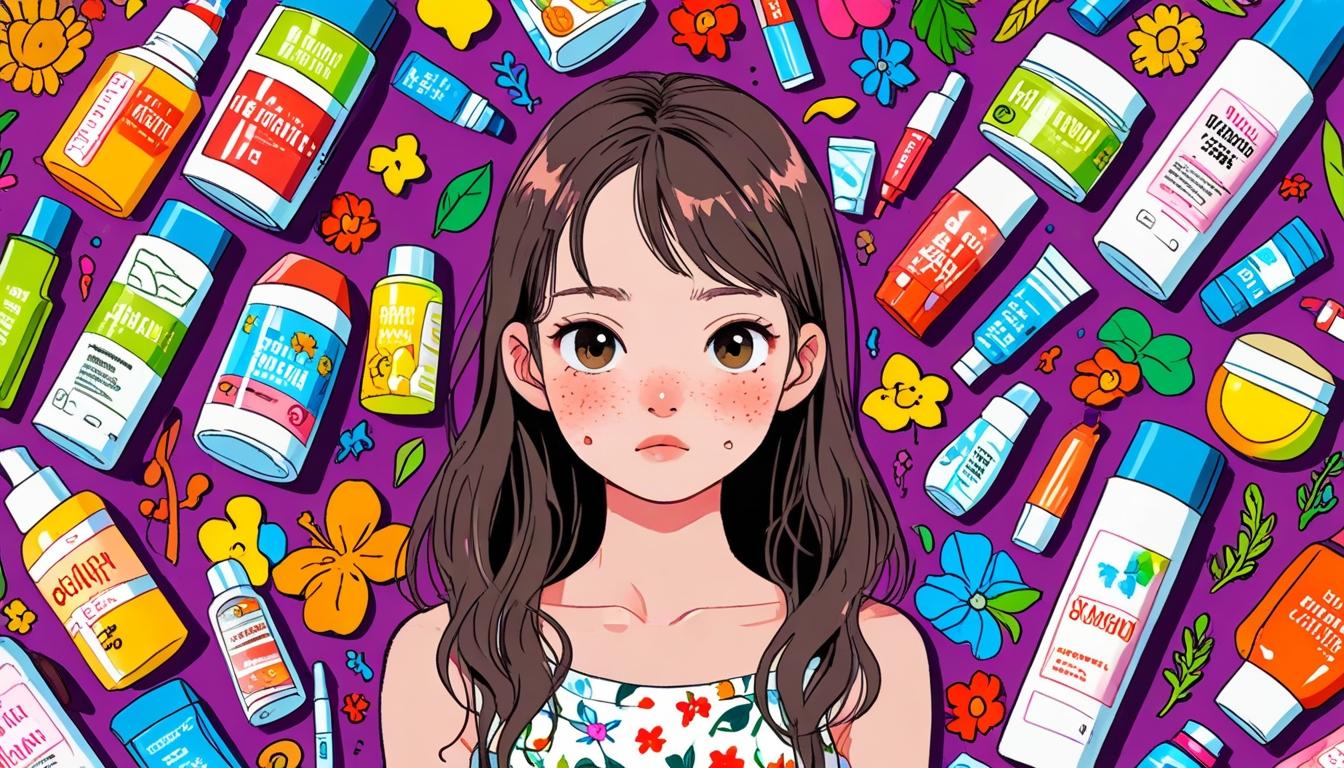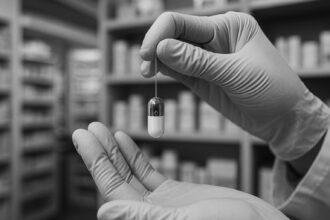Dermatologists warn of increasing severe skin conditions among tween girls caused by harsh chemicals in adult-grade skincare products aggressively marketed with social media influence, raising concerns about lasting physical and mental health impacts.
In recent years, there has been a troubling trend among young girls, particularly those in the ‘tween’ demographic, who are increasingly developing skin issues like severe eczema and acne due to the use of skincare products laden with harsh chemicals more suitable for adults. Dermatologists are observing a stark rise in such cases, raising concerns about the long-term impact on young users not only physical but on mental health as well.
Consultant dermatologist Dr Timothy Howel Clayton reports a worrying increase in children presenting with severe skin reactions linked to skincare products explicitly marketed to their age group. He highlights that many of these products feature bright, enticing packaging designed to attract young consumers, often incorporating enticing elements such as floral-shaped dispensers. However, these products frequently contain potent ingredients, including retinols and exfoliating acids, which can be detrimental to their still-developing skin.
The marketing behind these products is sophisticated and pervasive, amplified by social media. Many school-aged girls now aspire to elaborate skincare routines comprising up to 12 different products. This desire often stems from the unrealistic standards perpetuated by influencers on platforms like Instagram and TikTok, coupled with a fear of social exclusion from peers. Education expert Chloe Combi has expressed profound concern regarding this culture, referring to it as an unsettling echo of previous societal worries surrounding toxic masculinity. She describes the aggressive marketing tactics aimed at young girls as akin to cult behaviour, akin to strategies employed by vape paraphernalia companies that seek to develop “addictive” teen brands.
Indeed, a recent survey by Pai Skincare involving 1,500 girls aged between nine and 12 revealed that one in four had started using potentially harmful ingredients like Retinol and AHAs, which are unsuitable for young skin. The founder of Pai Skincare, Sarah Brown, attributes this trend to the naivety of parents who are often unaware of the harmful contents in these seemingly innocent products. She warns that without intervention, it is foreseeable that within just a few years, many of these children may find themselves requiring medical attention for both psychological and physical health issues stemming from their skincare habits.
In addition to the visible physical repercussions, dermatologists have raised alarms about the psychological risks. Dr Wisam Alwan, also a consultant dermatologist, notes that the adverse effects associated with these products can lead to severe allergic reactions and skin irritations, such as redness and flaking, that could pave the way for conditions like perioral dermatitis. He cautioned that such conditions not only harm skin health but also contribute to low self-esteem and anxiety in young girls striving for unattainable ideals of beauty.
The push for ‘tween skincare’ has even led to concerns regarding long-term health implications, including hormonal imbalances and an increased risk of skin cancer related to the use of aggressive skincare formulations. This growing awareness of the dangers posed by adult-targeted skincare products for prepubescent skin has prompted advocates, including those from the Environmental Working Group, to stress the need for age-appropriate skincare. They urge parents to direct their children toward gentler, tween-friendly alternatives to protect their delicate skin from potential harm.
As social media continues to influence the beauty standards embraced by younger generations, it is clear that the conversation surrounding skincare must evolve. Parents, educators, and dermatologists alike are called to step in, promoting education and awareness that prioritises skin health over market trends. The unfolding narrative around young skin care reveals not merely a battle against harmful products but a deeper struggle for identity and self-worth in an increasingly image-conscious society.
Reference Map
- Paragraph 1: [1]
- Paragraph 2: [1], [3], [4]
- Paragraph 3: [1], [2], [6]
- Paragraph 4: [1], [3], [6]
- Paragraph 5: [4], [5]
- Paragraph 6: [1], [4], [5]
- Paragraph 7: [3], [7], [6]
- Paragraph 8: [3], [5]
Source: Noah Wire Services
- https://www.dailymail.co.uk/news/article-14697611/Girls-skincare-eczema-acne-harsh-chemicals-dermatologist.html?ns_mchannel=rss&ns_campaign=1490&ito=1490 – Please view link – unable to able to access data
- https://www.ft.com/content/9ab6ea47-bae0-45e9-87ae-3453c2181bae – An article discussing the emergence of ‘Sephora kids,’ children as young as nine promoting beauty products on social media platforms. It highlights concerns about the promotion of products containing harsh chemicals like retinol to young audiences and the potential risks associated with such marketing strategies targeting children.
- https://www.ewg.org/news-insights/news/2024/07/protecting-sephora-kids-how-keep-tweens-safe-harmful-skin-care-and – This piece from the Environmental Working Group emphasizes the dangers of anti-aging skincare products for tweens, focusing on ingredients like retinol, vitamin C, and exfoliating acids. It advises parents to choose safer, tween-friendly skincare options and highlights the importance of protecting young skin from harmful chemicals.
- https://www.axios.com/2024/01/25/sephora-kids-tweens-anti-aging-skin-care-parents – An article from Axios highlighting expert opinions on the unnecessary and potentially harmful use of ‘anti-aging’ skincare products by tweens. It discusses how social media influences young people to experiment with products not suitable for their age, leading to skin issues and emphasizing the importance of basic skincare routines.
- https://www.uclahealth.org/news/article/kids-skincare-dermatologists-advice – A UCLA Health article providing advice from dermatologists on children’s skincare. It addresses concerns about preteens and teens using products with active ingredients like salicylic acid and retinols, which can irritate young skin, and recommends simple routines focusing on gentle cleansing, moisturizing, and sun protection.
- https://www.wamc.org/2024-07-12/social-media-is-fueling-a-tween-skin-care-craze-some-dermatologists-are-wary – This WAMC article discusses the trend of tweens adopting complex skincare routines influenced by social media. Dermatologists express concern over the use of products with active ingredients unsuitable for young skin, leading to issues like allergic contact dermatitis, and advocate for simpler skincare regimens.
- https://www.kpbs.org/news/health/2024/07/12/social-media-is-fueling-a-tween-skin-care-craze-some-dermatologists-are-wary – An article from KPBS Public Media highlighting the rise of ‘Sephora kids’ and the promotion of skincare products to young audiences. It discusses the potential harms of using products with ingredients like glycolic acid on preteen skin and the role of social media in influencing these trends.
Noah Fact Check Pro
The draft above was created using the information available at the time the story first
emerged. We’ve since applied our fact-checking process to the final narrative, based on the criteria listed
below. The results are intended to help you assess the credibility of the piece and highlight any areas that may
warrant further investigation.
Freshness check
Score:
8
Notes:
The narrative discusses recent trends and surveys, indicating it is relatively fresh. However, similar concerns have been raised in previous discussions on skincare for young girls.
Quotes check
Score:
6
Notes:
Quotes from Dr. Timothy Howel Clayton, Chloe Combi, and Sarah Brown appear original but lack specific online sources for verification. The quotes align with common concerns over skincare for tweens.
Source reliability
Score:
7
Notes:
The narrative originates from the Daily Mail, which is a well-known publication. However, it may have varied perceptions of bias. Additional references to reputable sources like Pai Skincare and the Environmental Working Group enhance credibility.
Plausability check
Score:
9
Notes:
The claims about skincare products containing harsh chemicals for young girls and their potential health impacts are plausible and supported by dermatological concerns. Recent surveys and reports from reputable sources suggest this is a valid issue.
Overall assessment
Verdict (FAIL, OPEN, PASS): PASS
Confidence (LOW, MEDIUM, HIGH): MEDIUM
Summary:
The narrative is generally plausible and highlights a contemporary issue. The freshness and source reliability are moderate, while the plausibility is high. However, more rigorous verification of quotes and sources would enhance confidence.













